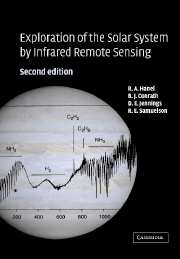Book contents
- Frontmatter
- Contents
- Introduction to first edition
- Introduction to second edition
- 1 Foundation of radiation theory
- 2 Radiative transfer
- 3 Interaction of radiation with matter
- 4 The emerging radiation field
- 5 Instruments to measure the radiation field
- 6 Measured radiation from planetary objects up to Neptune
- 7 Trans-Neptunian objects and asteroids
- 8 Retrieval of physical parameters from measurements
- 9 Interpretation of results
- Closing remarks
- Appendices
- References
- Abbreviations
- Index
Introduction to first edition
Published online by Cambridge University Press: 07 September 2009
- Frontmatter
- Contents
- Introduction to first edition
- Introduction to second edition
- 1 Foundation of radiation theory
- 2 Radiative transfer
- 3 Interaction of radiation with matter
- 4 The emerging radiation field
- 5 Instruments to measure the radiation field
- 6 Measured radiation from planetary objects up to Neptune
- 7 Trans-Neptunian objects and asteroids
- 8 Retrieval of physical parameters from measurements
- 9 Interpretation of results
- Closing remarks
- Appendices
- References
- Abbreviations
- Index
Summary
The advent of spaceflight has ushered in a new era of Solar System exploration. Man has walked on the Moon and returned with soil samples. Instrumented probes have descended through the atmospheres of Venus and Mars. The Mariner, Pioneer, Venera, Viking, and Voyager space flight programs have provided opportunities to study the planets from Mercury to Neptune and most of the satellites. Remote sensing investigations have been conducted with unprecedented spatial and spectral resolutions, permitting detailed examinations of atmospheres and surfaces. Even for the Earth, space-borne observations, obtained with global coverage and high spatial, spectral, and temporal resolutions, have revolutionized weather forcasting, climate research, and the exploration of natural resources.
The collective study of the various atmospheres and surfaces in the Solar System constitutes the field of comparative planetology. Wide ranges in surface gravity, solar flux, internal heat, obliquity, rotation rate, mass, and composition provide a broad spectrum of boundary conditions for atmospheric systems. Analyses of data within this context lead to an understanding of physical processes applicable to all planets. Once the general physical principles are identified, the evolution of planetary systems can be explored.
Some of the data needed to address the broader questions have already been collected. Infrared spectra, images, and many other types of data are available in varying amounts for Mercury, Venus, Earth, Mars, Jupiter, Saturn, Uranus, Neptune, and many of their satellites. It is now appropriate to review and assess the techniques used in obtaining the existing information.
- Type
- Chapter
- Information
- Exploration of the Solar System by Infrared Remote Sensing , pp. xi - xivPublisher: Cambridge University PressPrint publication year: 2003



